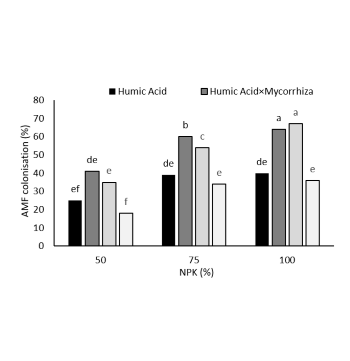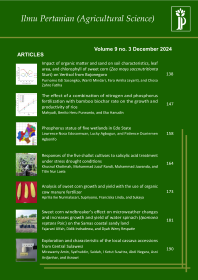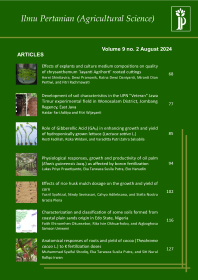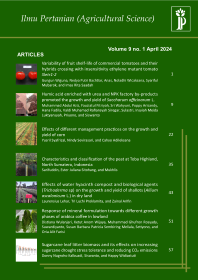
The role of mycorrhiza and humic acid on quantitative and qualitative traits of faba bean plant under different fertilizer regimes
Mandana Mirbakhsh(1*), Seyedeh Sara Sohrabi Sedeh(2)
(1) Purdue University
(2) Department of Plant Physiology, Alzahra University, Vanak Village Street, Tehran, Iran.
(*) Corresponding Author
Abstract
In sustainable agricultural ecosystem management, a key focus is on minimizing chemical fertilizer use and maximizing the use of non-chemical alternatives. Our study was designed to explore the impact of mycorrhizal fungi and humic acid (HA) on the quantitative and qualitative characteristics of faba beans under varying chemical fertilizer levels. The experiment involved different treatments, which included HA and mycorrhiza in four variations (control, HA, HA+ mycorrhiza, and mycorrhiza alone), and nitrogen, phosphorus, and potassium (NPK) fertilizers at three different dosages (50%, 75%, and 100% of the recommended amount). The findings revealed that combining HA with mycorrhiza significantly influenced root colonization, with the highest chlorophyll a concentration (1.58 mg g⁻¹) observed in the HA+ mycorrhiza treatment at 75% NPK. This treatment also led to the highest counts in seeds per pod, number of pods, and weight of 100 seeds. Between the 100% and 75% NPK levels in the HA+ mycorrhiza treatment, no significant differences were noted in terms of grain and biological yield. The greatest grain yields were measured at 4356 kg ha⁻¹ and 4322 kg ha⁻¹ for the HA+ mycorrhiza treatment at 100% and 75% NPK, respectively. Additionally, the highest concentrations of Fe, N, P, K, and Zn were observed with the HA+ mycorrhiza application at the 100% NPK level.
Keywords
Full Text:
PDFReferences
Aubert, G. (1978). Methodes d'analyses des sols: documents de travail tous droits reserves. In: G. Aubert, ed., Centre régional de documentation pédagogique. Marseille: C.R.D.P.
Ayas, H., and Gulser, F. (2005). The effects of sulfur and humic acid on yield components and macronutrient contents of spinach (Spinacia Oleracea Var. Spinoza). Journal Of Biological Sciences, 5(6), pp. 801–804.
Baize, D. (1988). Guide des analyses courantes en pédologie. Paris, France: INRA.
Bayoumi, M., and Selim, T. (2012). Effect of nitrogen, humic acid and bio-fertilization on productivity and quality of faba bean under saline condition. Journal of Soil Sciences and Agricultural Engineering, 3(8), pp. 829–843.
Biermann, B. and Linderman, R.G. (1981). Quantifying vesicular‐arbuscular mycorrhizae: a proposed method towards standardization. New Phytologist, 87(1), pp. 63–67.
Bitterlich, M., Franken, P., and Graefe, J. (2018). Arbuscular mycorrhiza improves substrate hydraulic conductivity in the plant available moisture range under root growth exclusion. Frontiers in Plant Science, 9, pp. 1–11.
Büyükkeskin, T., Akinci, Ş., and Eroğlu, A. E. (2015). Effects of humic acid on root development and nutrient uptake of Vicia faba L. (broad bean) seedlings grown under aluminum toxicity. Communications in Soil Science and Plant Analysis, 46(3), pp. 277–292.
Casson, S. A., and Lindsey, K. (2003). Genes and signalling in root development. New Phytologist, 158(1), pp. 11–38.
Daur, I., and Bakhashwain, A. A. (2013). Effect of humic acid on growth and quality of maize fodder production. Pak. J. Bot, 45(S1), pp. 21–25.
Dawood, M. G., Abdel-Baky, Y. R., El-Awadi, M. E. S., and Bakhoum, G. S. (2019). Enhancement quality and quantity of faba bean plants grown under sandy soil conditions by nicotinamide and/or humic acid application. Bulletin of the National Research Centre, 43(1), pp. 1–8.
Ding, Z., Ali, E. F., Almaroai, Y. A., Eissa, M. A., and Abeed, A. H. (2021). Effect of potassium solubilizing bacteria and humic acid on faba bean (Vicia faba L.) plants grown on sandy loam soils. Journal of Soil Science and Plant Nutrition, 21(1), pp. 791–800.
Dodd, I. C., and Pérez-Alfocea, F. (2012). Microbial amelioration of crop salinity stress. Journal of experimental botany, 63(9), pp. 3415–3428.
El-Hefny, E. M. (2010). Effect of saline irrigation water and humic acid application on growth and productivity of two cultivars of cowpea (Vigna unguiculata L. Walp). Australian Journal of Basic and Applied Sciences, 4(12), pp. 6154–6168.
El-Kholy, A. S., Aly, R., El-Bana, A., and Yasin, M. (2019). Yield of faba bean (vicia faba, l.) as influenced by planting density, humic acid rate and phosohorus fertilization level under drip irrigation system in sandy soils. Zagazig Journal of Agricultural Research, 46(6), pp. 1785–1795.
Eyheraguibel, B., Silvestre, J., and Morard, P. (2008). Effects of humic substances derived from organic waste enhancement on the growth and mineral nutrition of maize. Bioresource technology, 99(10), pp. 4206–4212.
FAO. (2022). Statistics Division. Food and Agriculture Organization of the United Nations, Rome. [online] Available at: http://www.fao.org/faostat/en/#home [Accessed 1 December 2022]
Fouda, K. (2017). Effect of phosphorus level and some growth regulators on productivity of faba bean (Vicia faba L.). Egypt. J. Soil Sci, 57(1), pp. 73–87.
Franken, P. (2012). The plant strengthening root endophyte Piriformospora indica: potential application and the biology behind. Applied Microbiology and Biotechnology, 96(6), pp. 1455–1464.
Haghighi, M. and Kafi, M. (2010). Effect of humic acid on the accumulation of cadmium, nitrate and changes of nitrate reductase activity in lettuce. Journal of Horticultural Science, 24(1).
Jamshidi, S., Zand-parsa, S., Pakparvar, M., and Niyogi, D. (2019). Evaluation of evapotranspiration over a semiarid region using multiresolution data sources. J. Hydrometeorol. 2019, 20, pp. 947–964.
Khaitov, B., and Teshaev, S. (2015). The effect of arbuscular mycorrhiza fungi on cotton growth and yield under salinated soil condition. Cotton Genomics and Genetics, 6(3), pp. 1–5.
Leij, D. (1998). Plant mediated interactions between Pseudomonas fluorescens, Rhizobium leguminosarum and arbuscular mycorrhizae on pea. Letters in Applied Microbiology, 26(4), pp. 311–316.
Liu, C., Cooper, R.J. and Bowman, D.C. (1998). Humic acid application affects photosynthesis, root development, and nutrient content of creeping bentgrass. Hort Science, 33(6), pp. 1023–1025.
Mirbakhsh, A., Lee, J., & Besenski, D. (2023). Spring–Mass–Damper-Based Platooning Logic for Automated Vehicles. Transportation research record, 2677(5), pp. 1264–1274.
Mirbakhsh, M. and Sedeh, S.S.S. (2022). Effect of short and long period of salinity stress on physiological responses and biochemical markers of Aloe vera L.. Ilmu Pertanian (Agricultural Science), 7(3), pp. 178–187.
Mirbakhsh, M. (2023). Role of nano-fertilizer in plants nutrient use efficiency (NUE). J. Gene. Eng. Bio. Res., 5, pp. 75–81.
Mirbakhsh, M., Brouder, S. M., and Volenec, J. J. (2022). Temporal Change of Carbon Stocks and Soil Health Indicators on a Long-Term Experimental Site: Annual Vs. Perennial Systems [Abstract]. [online] ASA, CSSA, SSSA International Annual Meeting, Baltimore, MD. Available at: https://scisoc.confex.com/scisoc/2022am/meetingapp.cgi/Paper/143204 [Accessed 1 December 2022]
Olsen, S., and Sommers, L. (1982). Phosphorus "Method of soil analysis. Chemical and microbiological properties" ASA & SSSA. Madison, pp. 403–430.
Pereira, S., Mucha, Â., Gonçalves, B., Bacelar, E., Látr, A., Ferreira, H., Oliveira, I., Rosa, E., and Marques, G. (2019). Improvement of some growth and yield parameters of faba bean (Vicia faba) by inoculation with Rhizobium laguerreae and arbuscular mycorrhizal fungi. Crop and Pasture Science, 70(7), pp. 595–605.
Phillips, J.M. and Hayman, D.S. (1970). Improved procedures for clearing roots and staining parasitic and vesicular-arbuscular mycorrhizal fungi for rapid assessment of infection. Transactions of the British mycological Society, 55(1), pp. 158–161.
Rady, M., Abd El-Mageed, T., Abdurrahman, H., and Mahdi, A. (2016). Humic acid application improves field performance of cotton (Gossypium barbadense L.) under saline conditions. Journal of Animal & Plant Sciences, 26(2), pp. 487–493.
Rodier, J., Legube, B., and Merlet, N. (1984). L’analyse de l’eau. 7eme édition. Paris, France.
Roudgarnejad, S., Samdeliri, M., Mirkalaei, A. M., and Moghaddam, M. N. (2021). The Role of Humic Acid Application on Quantitative and Qualitative Traits of Faba Bean (Vicia faba L.). Gesunde Pflanzen, 73(4), pp. 603–611.
Saia, S., Benítez, E., García-Garrido, J., Settanni, L., Amato, G., and Giambalvo, D. (2014). The effect of arbuscular mycorrhizal fungi on total plant nitrogen uptake and nitrogen recovery from soil organic material. The Journal of Agricultural Science, 152(3), pp. 370–378.
Samavat, S. (2007). Evaluation of humic acid in various organic materials and the effects of urban waste compost humic acid on some soil. Paper presented at the Proceedings of the Xth congress of soil science, Karaj, Iran.
Sawers, R. J., Gebreselassie, M. N., Janos, D. P., and Paszkowski, U. (2010). Characterizing variation in mycorrhiza effect among diverse plant varieties. Theoretical and Applied Genetics, 120(5), pp. 1029–1039.
Sharif, M., Khattak, R. A., and Sarir, M. (2002). Effect of different levels of lignitic coal derived humic acid on growth of maize plants. Communications in Soil Science and Plant Analysis, 33(19-20), pp. 3567–3580.
Tawaraya, K. (2003). Arbuscular mycorrhizal dependency of different plant species and cultivars. Soil Science and Plant Nutrition, 49(5), pp. 655–668.
Ulukan, H. (2008). Effect of soil applied humic acid at different sowing times on some yield components in wheat (Triticum spp.) hybrids. Int. J. Bot, 4(2), pp. 164–175.
Verlinden, G., Pycke, B., Mertens, J., Debersaques, F., Verheyen, K., Baert, G., Bries, J., and Haesaert, G. (2009). Application of humic substances results in consistent increases in crop yield and nutrient uptake. Journal of Plant Nutrition, 32(9), pp. 1407–1426.
Wright, D. and Lenssen, A.W. (2013). Humic and fulvic acids and their potential in crop production. Agricultural and Food Sciences, Environmental Science, 2013.
Zhang, T., Hu, Y., Zhang, K., Tian, C., and Guo, J. (2018). Arbuscular mycorrhizal fungi improve plant growth of Ricinus communis by altering photosynthetic properties and increasing pigments under drought and salt stress. Industrial Crops and Products, 117, pp. 13–19.
Zhu, X., Song, F., Liu, S., Liu, T., and Zhou, X. (2012). Arbuscular mycorrhizae improves photosynthesis and water status of Zea mays L. under drought stress. Plant, Soil and Environment, 58(4), pp. 186–191.
Article Metrics
Refbacks
- There are currently no refbacks.
Ilmu Pertanian (Agricultural Science) ISSN 0126-4214 (print), ISSN 2527-7162 (online) is published by Faculty of Agriculture Universitas Gadjah Mada collaboration with Perhimpunan Sarjana Pertanian Indonesia (PISPI) and licensed under a Creative Commons Attribution-ShareAlike 4.0 International License.













